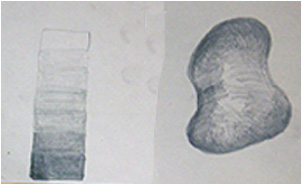Fourth Grade Art Lesson 3
Elements of Art, Part 2 Value / Making Shapes Into Forms
Objective:
The student will use value to make a shape look like a form. The student will make their own grey scale to use as a reference for seeing the range of values.
Materials:
2 more of the same type paper or cards you have been using, a black crayon
Procedure:
Today we will look at the art elements value and form. We will look at them together because value reveals form. So what is a form? Form is a three dimensional object. The word dimension means measurement. So if something is three dimensional it has three measurements; height, width and depth. When we try to make an object appear three dimensional on a two dimensional surface, we need to use value. So what is value? Value is the range of lightness or darkness of a color or the range between black and white. On your first card I want you to draw something called a grey scale to help you see just how many different values you can create with a simple black crayon. Begin at the top and draw off a small square. Color in this square and dark as you can. Make it very solid and very black. Underneath that square, draw off another square and color it in almost as dark as you did the first one, only a little bit lighter. Continue with this pattern until you have at least five different values. The last square should be white. Keep your grey scale in front of you when you are working with value to help remind you of just how many different values you can get with one crayon. On your second card, lightly draw off an organic shape. We will use value to turn this two dimensional shape into a three dimensional form. (Of course you need to remember we are dealing with illusions here, we can't actually change it, and we can only make it appear to change.) To do this effectively, start on one edge of your shape and color around the shape. When I say color around the edge I mean for you to color in a curved motion. This will help emphasize the form. If you color straight across you form it will continue to look flat. This requires a lot of control which will come with practice. As you color around your form you need to change your values. Use the darker ones on the edges and lighten up as you move across to the top. You may need to do several examples until you get a drawing that looks as though an actual blob is on your paper. Do as many as you have time for to help you master using value to create form.
Conclusion:
The most important thing you have been told today is that value reveals form. Try to keep this in mind whenever you are trying to do realistic drawings. Keep both your grey scale and you form study to refer to throughout the year.
Artwork and Examples used in this lesson

Teacher Example













